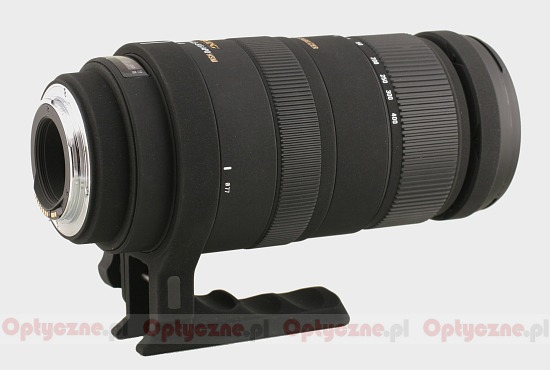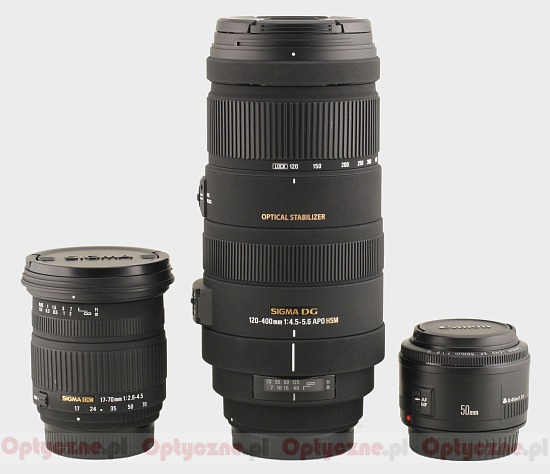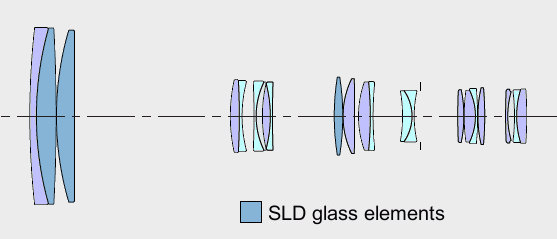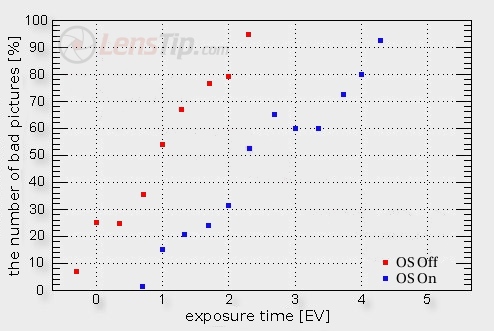Sigma 120-400 mm f/4.5-5.6 APO DG OS HSM
3. Build quality and image stabilization
 |
On Sigma’s body, moving from the metal bayonet, we find a legible focus scale extending from 1.5 meter to infinity, a place for mounting the tripod mount ring, next the symbol of the lens, and, on the left side of it, switches of the focusing mechanism mode (AF/MF) are stabilization modes IS (Off, Mode 1 for general purposes and Mode 2 for subjects moving parallel to the image plane). Moving further we find a convenient ring for manual focusing, behind it, a little to the left, a switch of locking the lens’ protrusion (Lock/Unlock) and next a big and convenient ring for changing the focal length, which works smoothly and with an accurate resistance.
The front system of lenses, surrounded with a non-rotating filter thread of 77 mm diameter, protrudes on a uniform tube making the lens grow in length by a factor of about 1.5 times. It’s worth to notice here that Tokina and Sigma have a classic system of changing the focal length, and with Canon 100-400 mm IS we find, once more popular, “pump”.
Please Support UsIf you enjoy our reviews and articles, and you want us to continue our work please, support our website by donating through PayPal. The funds are going to be used for paying our editorial team, renting servers, and equipping our testing studio; only that way we will be able to continue providing you interesting content for free. |
- - - - - - - - - - - - - - - - - - - - - - - - - - - - - - - - - - - - - - - - - - - - - - - -
In terms of dimensions, Sigma seems to be noticeably bigger and heavier from the instruments of its class. The table shows its comparison to Canon 100-400 mm IS, Nikkor 80-400 mm VR and Tokina 80-400 mm. While small dimensions and weight of Tokina may be understood (lack of stabilization and ultrasonic), actually there’s a question of why Sigma, despite having the smallest focal length range, is noticeably longer and heavier than Canon and Nikkor? Definitely, part of the answer we’ll find looking at the number of lenses, which is the biggest in Sigma. Is such a complex optical system going to translate into good results as regards image quality? We’ll find about that in the further chapters.
 |
If were at the number of lenses, it’s worth to remind you here that Sigma 120-400 mm OS consists of as much as 21 elements set in 15 groups. As much as three lenses (including two of three big ones in the front system) are made of low dispersion SLD (Special Low Dispersion) glass. Inside we also find a 9 blade diaphragm which, depending on the focal length, can be closed to f/22-29.

Stabilization
Image stabilization (OS), based on two sensors registering vertical and horizontal movements, is supposed to be efficient, according to the manufacturer, up to 4 EV. That means sixteen times lengthening the exposure time, without blurring the image, compared to an analogues lens without stabilization.
Our test, conducted at 120 mm focal length, showing the number of unsuccessful pictures with stabilization on and off, for different exposure times is displayed at the picture below. The zero point on the horizontal expressed in exposure values corresponds 1/200 second.

As you can see, the mechanism if far from the declared efficiency of 4 EV. At the beginning it’s even slightly smaller than 2 EV, to reach just above 2 EV for longer times. On average, our test showed that the efficiency of this mechanism can result in only as much as 2 EV. It’s the same value as for Canon’s L-lenses 100-400 mm and 4/300 equipped with the first generation IS.






